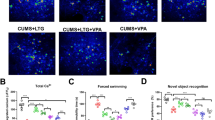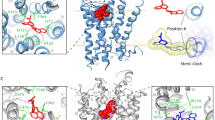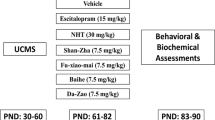Abstract
The BH3-interacting domain death agonist (Bid) is a pro-apoptotic member of the B-cell lymphoma-2 (Bcl-2) protein family. Previous studies have shown that stress reduces levels of Bcl-2 in brain regions implicated in the pathophysiology of mood disorders, whereas antidepressants and mood stabilizers increase Bcl-2 levels. The Bcl-2 protein family has an essential role in cellular resilience as well as synaptic and neuronal plasticity and may influence mood and affective behaviors. This study inhibited Bid in mice using two pharmacological antagonists (BI-11A7 and BI-2A7); the selective serotonin reuptake inhibitor citalopram was used as a positive control. These agents were studied in several well-known rodent models of depression—the forced swim test (FST), the tail suspension test (TST), and the learned helplessness (LH) paradigm—as well as in the female urine sniffing test (FUST), a measure of sex-related reward-seeking behavior. Citalopram and BI-11A7 both significantly reduced immobility time in the FST and TST and attenuated escape latencies in mice that underwent the LH paradigm. In the FUST, both agents significantly improved duration of female urine sniffing in mice that had developed helplessness. LH induction increased the activation of apoptosis-inducing factor (AIF), a caspase-independent cell death constituent activated by Bid, and mitochondrial AIF expression was attenuated by chronic BI-11A7 infusion. Taken together, the results suggest that functional perturbation of apoptotic proteins such as Bid and, alternatively, enhancement of Bcl-2 function, is a putative strategy for developing novel therapeutics for mood disorders.
This is a preview of subscription content, access via your institution
Access options
Subscribe to this journal
Receive 12 print issues and online access
$259.00 per year
only $21.58 per issue
Buy this article
- Purchase on Springer Link
- Instant access to full article PDF
Prices may be subject to local taxes which are calculated during checkout






Similar content being viewed by others
References
Duman RS . Neuronal damage and protection in the pathophysiology and treatment of psychiatric illness: stress and depression. Dialog Clin Neurosci 2009; 11: 239–255.
Belmaker RH, Agam G . Major depressive disorder. N Engl J Med 2008; 358: 55–68.
Hunsberger J, Austin DR, Henter ID, Chen G . The neurotrophic and neuroprotective effects of psychotropic agents. Dialog Clin Neurosci 2009; 11: 333–348.
Manji HK, Drevets WC, Charney DS . The cellular neurobiology of depression. Nat Med 2001; 7: 541–547.
Goldman LS, Nielsen NH, Champion HC . Awareness, diagnosis, and treatment of depression. J Gen Intern Med 1999; 14: 569–580.
Simon GE . Social and economic burden of mood disorders. Biol Psychiatry 2003; 54: 208–215.
World Health Organization. The Global Burden of Disease (GBD) 2004 Update. 2008 (cited 1 October 2009); available from: http://www.who.int/healthinfo/global_burden_disease/2004_report_update/en/index.html.
Angst F, Stassen HH, Clayton PJ, Angst J . Mortality of patients with mood disorders: follow-up over 34–38 years. J Affect Disord 2002; 68: 167–181.
Harris EC, Barraclough B . Excess mortality of mental disorder. Br J Psychiatry 1998; 173: 11–53.
Hiroeh U, Appleby L, Mortensen PB, Dunn G . Death by homicide, suicide, and other unnatural causes in people with mental illness: a population-based study. Lancet 2001; 358: 2110–2112.
Goodwin FK, Jamison KR . Manic-Depressive Illness: Bipolar and Recurrent Unipolar Disorders, 2nd edn. Oxford University Press: New York, 2007.
Krishnan V, Nestler EJ . The molecular neurobiology of depression. Nature 2008; 455: 894–902.
Coyle JT, Duman RS . Finding the intracellular signaling pathways affected by mood disorder treatments. Neuron 2003; 38: 157–160.
Manji HK, Quiroz JA, Sporn J, Payne JL, Denicoff K, A Gray N et al. Enhancing neuronal plasticity and cellular resilience to develop novel, improved therapeutics for difficult-to-treat depression. Biol Psychiatry 2003; 53: 707–742.
Hunsberger JG, Austin DR, Chen G, Manji HK . Cellular mechanisms underlying affective resiliency: the role of glucocorticoid receptor- and mitochondrially-mediated plasticity. Brain Res 2009; 1293: 76–84.
Hunsberger JG, Austin DR, Chen G, Manji HK . MicroRNAs in mental health: from biological underpinnings to potential therapies. Neuromol Med 2009; 11: 173–182.
Reed JC . Apoptosis mechanisms: implications for cancer drug discovery. Oncology (Williston Park) 2004; 13 (Suppl 10): 11–20.
Yip KW, Reed JC . Bcl-2 family proteins and cancer. Oncogene 2008; 27: 6398–6406.
Hetz C, Glimcher L . The daily job of night killers: alternative roles of the BCL-2 family in organelle physiology. Trends Cell Biol 2008; 18: 38–44.
Youle RJ, Strasser A . The BCL-2 protein family: opposing activities that mediate cell death. Nat Rev Mol Cell Biol 2008; 9: 47–59.
Kuhn HG, Biebl M, Wilhelm D, Li M, Friedlander RM, Winkler J . Increased generation of granule cells in adult Bcl-2-overexpressing mice: a role for cell death during continued hippocampal neurogenesis. Eur J Neurosci 2005; 22: 1907–1915.
Chen G, Ray R, Dubik D, Shi L, Cizeau J, Bleackley RC et al. The E1B 19K/Bcl-2-binding protein Nip3 is a dimeric mitochondrial protein that activates apoptosis. J Exp Med 1997; 186: 1975–1983.
Hao Y, Creson T, Zhang L, Li P, Du F, Yuan P et al. Mood stabilizer valproate promotes ERK pathway-dependent cortical neuronal growth and neurogenesis. J Neurosci 2004; 24: 6590–6599.
Yuan P, Huang LD, Jiang YM, Gutkind JS, Manji HK, Chen G . The mood stabilizer valproic acid activates mitogen-activated protein kinases and promotes neurite growth. J Biol Chem 2001; 276: 31674–31683.
Jonas E . BCL-xL regulates synaptic plasticity. Mol Interv 2006; 6: 208–222.
Mattson MP . Mitochondrial regulation of neuronal plasticity. Neurochem Res 2007; 32: 707–715.
Kosten TA, Galloway MP, Duman RS, Russell DS, D'Sa C . Repeated unpredictable stress and antidepressants differentially regulate expression of the bcl-2 family of apoptotic genes in rat cortical, hippocampal, and limbic brain structures. Neuropsychopharmacology 2007; 33: 1545–1558.
Huang YY, Peng CH, Yang YP, Wu CC, Hsu WM, Wang HJ et al. Desipramine activated Bcl-2 expression and inhibited lipopolysaccharide-induced apoptosis in hippocampus-derived adult neural stem cells. J Pharmacol Sci 2007; 104: 61–72.
Murray F, Hutson PH . Hippocampal Bcl-2 expression is selectively increased following chronic but not acute treatment with antidepressants, 5-HT(1A) or 5-HT(2C/2B) receptor antagonists. Eur J Pharmacol 2007; 13: 41–47.
Xu H, Richardson J, Li XM . Dose-related effects of chronic antidepressants on neuroprotective proteins BDNF, Bcl-2 and Cu/Zn-SOD in rat hippocampus. Neuropsychopharmacology 2003; 28: 53–62.
Bravo JA, Diaz-Veliz G, Mora S, Ulloa JL, Berthoud VM, Morales P et al. Desipramine prevents stress-induced changes in depressive-like behavior and hippocampal markers of neuroprotection. Behav Pharmacol 2009; 20: 273–285.
Maeng S, Hunsberger JG, Pearson B, Yuan P, Wang Y, Wei Y et al. BAG1 plays a critical role in regulating recovery from both manic-like and depression-like behavioral impairments. Proc Natl Acad Sci USA 2008; 105: 8766–8771.
Schendel SL, Azimov R, Pawlowski K, Godzik A, Kagan BL, Reed JC . Ion channel activity of the BH3 only Bcl-2 family member, BID. J Biol Chem 1999; 274: 21932–21936.
Breckenridge DG, Stojanovic M, Marcellus RC, Shore GC . Caspase cleavage product of BAP31 induces mitochondrial fission through endoplasmic reticulum calcium signals, enhancing cytochrome c release to the cytosol. J Cell Biol 2003; 160: 1115–1127.
Cregan SP, Dawson VL, Slack RS . Role of AIF in caspase-dependent and caspase-independent cell death. Oncogene 2004; 23: 2785–2796.
Yin XM, Wang K, Gross A, Zhao Y, Zinkel S, Klocke B et al. Bid-deficient mice are resistant to Fas-induced hepatocellular apoptosis. Nature 1999; 400: 886–891.
Zou H, Li Y, Liu X, Wang X . An APAF-1 cytochrome c multimeric complex is a functional apoptosome that activates procaspase-9. J Biol Chem 1999; 274: 11549–11556.
Plesnila N, Zinkel S, Le DA, Amin-Hanjani S, Wu Y, Qiu J et al. BID mediates neuronal cell death after oxygen/glucose deprivation and focal cerebral ischemia. Proc Natl Acad Sci USA 2001; 98: 15318–15323.
Culmsee C, Zhu C, Landshamer S, Becattini B, Wagner E, Pellecchia M et al. Apoptosis-inducing factor triggered by poly(ADP-ribose) polymerase and Bid mediates neuronal cell death after oxygen-glucose deprivation and focal cerebral ischemia. J Neurosci 2005; 25: 10262–10272.
Cregan SP, Fortin A, MacLaurin JG, Callaghan SM, Cecconi F, Yu SW et al. Apoptosis-inducing factor is involved in the regulation of caspase-independent neuronal cell death. J Cell Biol 2002; 158: 507–517.
Becattini B, Culmsee C, Leone M, Zhai D, Zhang X, Crowell KJ et al. Structure-activity relationships by interligand NOE-based design and synthesis of antiapoptotic compounds targeting Bid. Proc Natl Acad Sci USA 2006; 103: 12602–12606.
Becattini B, Sareth S, Zhai D, Crowell KJ, Leone M, Reed JC et al. Targeting apoptosis via chemical design: inhibition of bid-induced cell death by small organic molecules. Chem Biol 2004; 11: 1107–1117.
Thakker DR, Natt F, Husken D, van der Putten H, Maier R, Hoyer D et al. siRNA-mediated knockdown of the serotonin transporter in the adult mouse brain. Mol Psychiatry 2005; 10: 782–789.
Xu B, Pu S, Kalra PS, Hyde JF, Crowley WR, Kalra SP . An interactive physiological role of neuropeptide Y and galanin in pulsatile pituitary luteinizing hormone secretion. Endocrinology 1996; 137: 5297–5302.
Shaltiel G, Maeng S, Malkesman O, Pearson B, Schloesser RJ, Tragon T et al. Evidence for the involvement of the kainate receptor subunit GluR6 (GRIK2) in mediating behavioral displays related to behavioral symptoms of mania. Mol Psychiatry 2008; 13: 858–872.
Gould TD, O'Donnell KC, Dow ER, Du J, Chen G, Manji HK . Involvement of AMPA receptors in the antidepressant-like effects of lithium in the mouse tail suspension test and forced swim test. Neuropharmacology 2008; 54: 577–587.
Maeng S, Zarate Jr CA, Du J, Schloesser RJ, McCammon J, Chen G et al. Cellular mechanisms underlying the antidepressant effects of ketamine: role of alpha-amino-3-hydroxy-5-methylisoxazole-4-propionic acid receptors. Biol Psychiatry 2008; 63: 349–352.
Malkesman O, Scattoni ML, Paredes D, Tragon T, Pearson B, Shaltiel G et al. The female urine sniffing test: a novel approach for assessing reward-seeking behavior in rodents. Biol Psychiatry 2010; 67: 864–871.
Malkesman O, Austin DR, Chen G, Manji HK . Reverse translational strategies for developing animal models of bipolar disorder. Dis Model Mech 2009; 2: 238–245.
Cryan JF, Mombereau C . In search of a depressed mouse: utility of models for studying depression-related behavior in genetically modified mice. Mol Psychiatry 2004; 9: 326–357.
Cryan JF, Mombereau C, Vassout A . The tail suspension test as a model for assessing antidepressant activity: review of pharmacological and genetic studies in mice. Neurosci Biobehav Rev 2005; 29: 571–625.
Cryan JF, Markou A, Lucki I . Assessing antidepressant activity in rodents: recent developments and future needs. Trends Pharmacol Sci 2002; 23: 238–245.
Engin E, Treit D, Dickson CT . Anxiolytic- and antidepressant-like properties of ketamine in behavioral and neurophysiological animal models. Neuroscience 2009; 161: 359–369.
Foreman MM, Hanania T, Stratton SC, Wilcox KS, White HS, Stables JP et al. In vivo pharmacological effects of JZP-4, a novel anticonvulsant, in models for anticonvulsant, antimania and antidepressant activity. Pharmacol Biochem Behav 2008; 89: 523–534.
Liu X, Peprah D, Gershenfeld HK . Tail-suspension induced hyperthermia: a new measure of stress reactivity. J Psychiatr Res 2003; 37: 249–259.
Lucki I, Dalvi A, Mayorga AJ . Sensitivity to the effects of pharmacologically selective antidepressants in different strains of mice. Psychopharmacology (Berl) 2001; 155: 315–322.
Abel EL . Ontogeny of immobility and response to alarm substance in the forced swim test. Physiol Behav 1993; 54: 713–716.
Mayorga AJ, Lucki I . Limitations on the use of the C57BL/6 mouse in the tail suspension test. Psychopharmacology (Berl) 2001; 155: 110–112.
Mombereau C, Kaupmann K, Froestl W, Sansig G, van der Putten H, Cryan JF . Genetic and pharmacological evidence of a role for GABA(B) receptors in the modulation of anxiety- and antidepressant-like behavior. Neuropsychopharmacology 2004; 29: 1050–1062.
Porsolt R, Lenegre A . Behavioral models of depresion. In: Elliot J, Heal D, Marsden C (eds). Experimental Approaches to Anxiety and Depression. Wiley and Sons: London, 1992, pp 73–85.
Chourbaji S, Zacher C, Sanchis-Segura C, Dormann C, Vollmayr B, Gass P . Learned helplessness: validity and reliability of depressive-like states in mice. Brain Res Brain Res Protoc 2005; 16: 70–78.
Henn FA, Edwards E, Muneyyirci . Animal models of depression. Clin Neurosci 1993; 1: 152–156.
Gambarana C, Scheggi S, Tagliamonte A, Tolu P, DeMontis MG . Animal models for the study of antidepressant activity. Brain Res Brain Res Protoc 2001; 7: 11–20.
Henkel V, Bussfeld P, Moller HJ, Hegerl U . Cognitive–behavioural theories of helplessness/hopelessness: valid models of depression? Eur Arch Psychiatry Clin Neurosci 2002; 252: 240–249.
American Psychiatric Association. Diagnostic and Statistical Manual of Mental Disorders. Fourth Edition (DSM-IV). American Psychiatric Association: Washington, DC, 2000.
Li N, Lee B, Liu RJ, Banasr M, Dwyer JM, Iwata M et al. mTOR-dependent synapse formation underlies the rapid antidepressant effects of NMDA antagonists. Science 2010; 329: 959–964.
Maier SF . Learned helplessness and animal models of depression. Prog Neuropsychopharmacol Biol Psychiatry 1984; 8: 435–446.
Plesnila N, Zhu C, Culmsee C, Groger M, Moskowitz MA, Blomgren K . Nuclear translocation of apoptosis-inducing factor after focal cerebral ischemia. J Cereb Blood Flow Metab 2004; 24: 458–466.
Cheung EC, Melanson-Drapeau L, Cregan SP, Vanderluit JL, Ferguson KL, McIntosh WC et al. Apoptosis-inducing factor is a key factor in neuronal cell death propagated by BAX-dependent and BAX-independent mechanisms. J Neurosci 2005; 25: 1324–1334.
Landshamer S, Hoehn M, Barth N, Duvezin-Caubet S, Schwake G, Tobaben S et al. Bid-induced release of AIF from mitochondria causes immediate neuronal cell death. Cell Death Differ 2008; 15: 1553–1563.
McKernan DP, Dinan TG, Cryan JF . ‘Killing the Blues’: a role for cellular suicide (apoptosis) in depression and the antidepressant response? Prog Neurobiol 2009; 88: 246–263.
Drzyzga LR, Marcinowska A, Obuchowicz E . Antiapoptotic and neurotrophic effects of antidepressants: a review of clinical and experimental studies. Brain Res Bull 2009; 79: 248–257.
Acknowledgements
We would like to acknowledge the support of the Intramural Research Program of the National Institute of Mental Health (NIMH: OM, TT, DRA, IDH, GC and HKM) and NIH Grant (R01 HL082574) to JCR. Adithya Simha provided invaluable technical assistance.
Author information
Authors and Affiliations
Corresponding author
Ethics declarations
Competing interests
There are no personal financial holdings that could be perceived as constituting a potential conflict of interest. Drs Chen and Manji are now at Johnson & Johnson Pharmaceutical Research and Development; this work was initiated and largely undertaken while they were employees of the NIMH.
Rights and permissions
About this article
Cite this article
Malkesman, O., Austin, D., Tragon, T. et al. Targeting the BH3-interacting domain death agonist to develop mechanistically unique antidepressants. Mol Psychiatry 17, 770–780 (2012). https://doi.org/10.1038/mp.2011.77
Received:
Revised:
Accepted:
Published:
Issue Date:
DOI: https://doi.org/10.1038/mp.2011.77
Keywords
This article is cited by
-
Anastasis: cell recovery mechanisms and potential role in cancer
Cell Communication and Signaling (2022)
-
Features of the Responses of the Protective Systems of the Brain in Adult Rats to Stressors and Lipopolysaccharide
Neuroscience and Behavioral Physiology (2021)
-
Discovery and validation of blood biomarkers for suicidality
Molecular Psychiatry (2013)
-
Impaired mitochondrial function in psychiatric disorders
Nature Reviews Neuroscience (2012)



